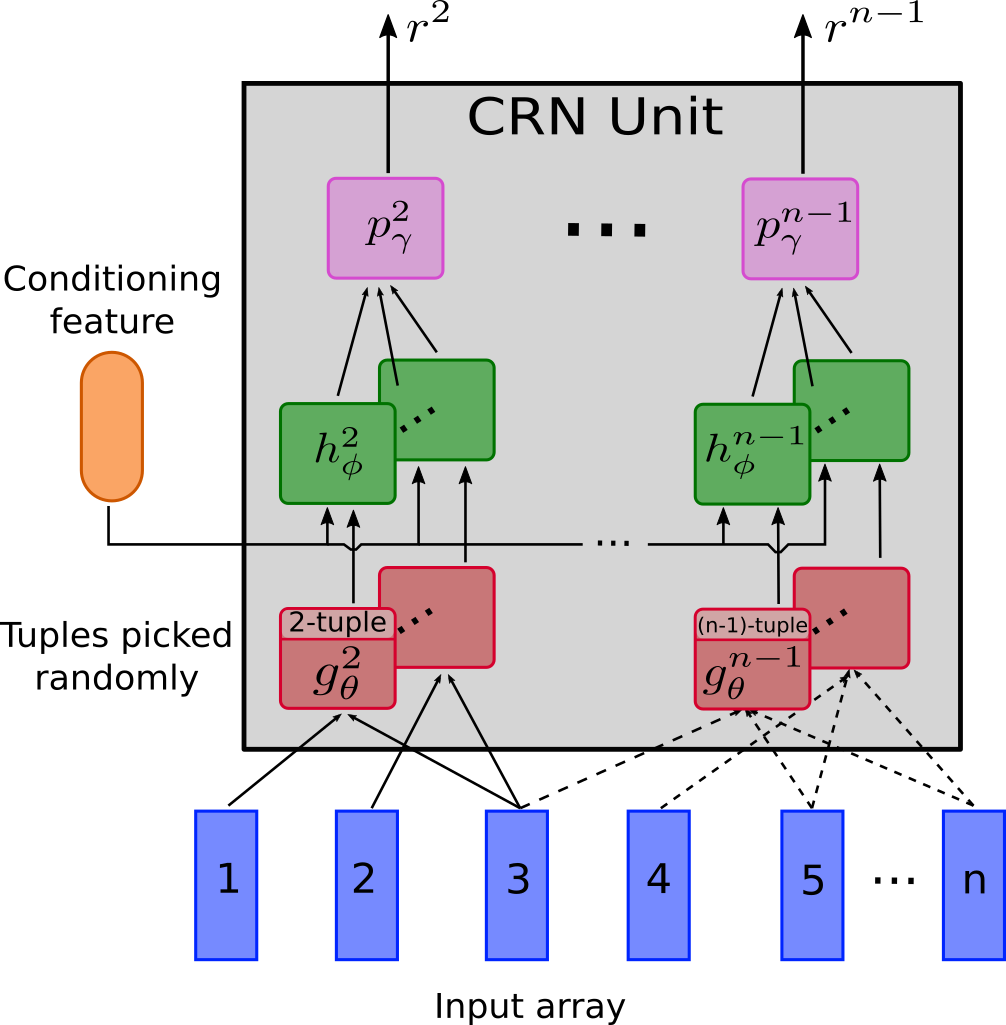We introduce a general-purpose reusable neural unit called Conditional Relation Network (CRN) that encapsulates and transforms an array of tensorial objects into a new array of the same kind, conditioned on a contextual feature. The flexibility of CRN units is then examined in solving Video Question Answering, a challenging problem requiring joint comprehension of video content and natural language processing.
Illustrations of CRN unit and the result of model building HCNR for VideoQA:
| CRN Unit | HCRN Architecture |
|---|---|
 |
 |
Check out our paper for details.
- Clone the repository:
git clone https://github.com/thaolmk54/hcrn-videoqa.git
-
Download TGIF-QA, MSRVTT-QA, MSVD-QA dataset and edit absolute paths in
preprocess/preprocess_features.pyandpreprocess/preprocess_questions.pyupon where you locate your data. Default paths are with/ceph-g/lethao/datasets/{dataset_name}/. -
Install dependencies:
conda create -n hcrn_videoqa python=3.6
conda activate hcrn_videoqa
conda install -c conda-forge ffmpeg
conda install -c conda-forge scikit-video
conda install pytorch==1.4.0 torchvision==0.5.0 -c pytorch
> torch==1.2.0
> torchvision==0.2.1
> FAILED!
pip install -r requirements.txtDepending on the task to chose question_type out of 4 options: action, transition, count, frameqa.
- To extract appearance feature:
python preprocess/preprocess_features.py --gpu_id 2 --dataset tgif-qa --model resnet101 --question_type {question_type}
-
To extract motion feature:
Download ResNeXt-101 pretrained model (resnext-101-kinetics.pth) and place it to
data/preprocess/pretrained/.
python preprocess/preprocess_features.py --dataset tgif-qa --model resnext101 --image_height 112 --image_width 112 --question_type {question_type}
Note: Extracting visual feature takes a long time. You can download our pre-extracted features from here and save them in data/tgif-qa/{question_type}/. Please use the following command to join split files:
cat tgif-qa_{question_type}_appearance_feat.h5.part* > tgif-qa_{question_type}_appearance_feat.h5
cat tgif-qa_count_appearance_feat.h5.part* > tgif-qa_count_appearance_feat.h5
cat tgif-qa_frameqa_appearance_feat.h5.part* > tgif-qa_frameqa_appearance_feat.h5
cat tgif-qa_transition_appearance_feat.h5.part* > tgif-qa_transition_appearance_feat.h5
- Download glove pretrained 300d word vectors to
data/glove/and process it into a pickle file:
python txt2pickle.py
- Preprocess train/val/test questions:
python preprocess/preprocess_questions.py --dataset tgif-qa --question_type {question_type} --glove_pt data/glove/glove.840.300d.pkl --mode train
python preprocess/preprocess_questions.py --dataset tgif-qa --question_type {question_type} --mode test
Choose a suitable config file in configs/{task}.yml for one of 4 tasks: action, transition, count, frameqa to train the model. For example, to train with action task, run the following command:
python train.py --cfg configs/tgif_qa_action.ymlTo evaluate the trained model, run the following:
python validate.py --cfg configs/tgif_qa_action.ymlNote: Pretrained model for action task is available here. Save the file in results/expTGIF-QAAction/ckpt/ for evaluation.
The following is to run experiments with MSRVTT-QA dataset, replace msrvtt-qa with msvd-qa to run with MSVD-QA dataset.
- To extract appearance feature:
python preprocess/preprocess_features.py --gpu_id 2 --dataset msrvtt-qa --model resnet101
- To extract motion feature:
python preprocess/preprocess_features.py --dataset msrvtt-qa --model resnext101 --image_height 112 --image_width 112
Preprocess train/val/test questions:
python preprocess/preprocess_questions.py --dataset msrvtt-qa --glove_pt data/glove/glove.840.300d.pkl --mode train
python preprocess/preprocess_questions.py --dataset msrvtt-qa --question_type {question_type} --mode val
python preprocess/preprocess_questions.py --dataset msrvtt-qa --question_type {question_type} --mode test
python train.py --cfg configs/msrvtt_qa.ymlTo evaluate the trained model, run the following:
python validate.py --cfg configs/msrvtt_qa.ymlIf you make use of this repository for your research, please cite the following paper:
@article{le2020hierarchical,
title={Hierarchical Conditional Relation Networks for Video Question Answering},
author={Le, Thao Minh and Le, Vuong and Venkatesh, Svetha and Tran, Truyen},
journal={arXiv preprint arXiv:2002.10698},
year={2020}
}